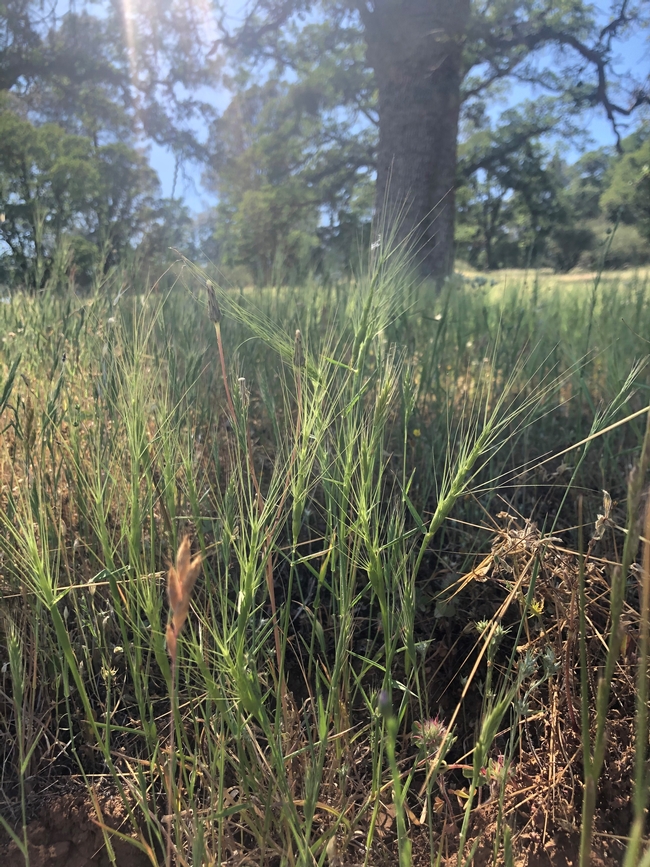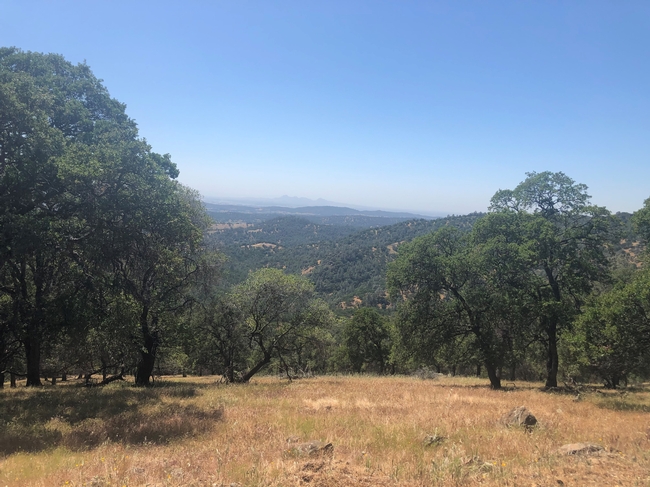If you've read my blog posts or newsletters over the last four years, you'll probably recognize that drought is a recurring theme - in my writing, in my extension programming, and in my research. Having ranched through the 2012-2015 drought, I tend to get a little nervous whenever we go through an unusual dry and/or warm stretch during our "normal" rainy season. And over the last six months, I've written about drought planning, feeding supplemental protein to utilize dry forage, and options for hauling drinking water to livestock. But all of these blog posts were written with the hope that we still had time for the rains to come - that we still had time to avoid a second consecutive dry year. Now that we're in the first week of May, I can say with more confidence (not to mention, disappointment) - we're in a drought here in the Sierra foothills.
I suppose most of us think about lack of rain or snow when we think of drought - and that's been a feature of this year's drought, to be sure. Through April 30, we've measured 18.7 inches of rainfall for the water year (since October 1, 2020). In the 20 years I've kept records here in Auburn, this is the lowest amount of precipitation I've recorded - lower, even, than the 2013-14 drought. As of May 1, we're sitting at 62 percent of average, based on my records.
But rainfall doesn't tell the whole story of this year's drought. January 2021 was the only month if this water year with above average rainfall. April, on the other hand, saw us measure just 6 percent of our average monthly precipitation. In fact, I've come to think of drought as a "climatic water deficit" - an event that combines low precipitation with higher environmental water demand, which we've also seen in the foothills this year.
The factors that drive this higher demand are numerous. Since last year was drier and warmer than normal, I suspect that we entered the current water year with very dry soils. This year's rainfall never truly re-saturated these soils, as evidenced by the lack of flow in our seasonal creeks - this is the first spring since I've lived in Auburn that I didn't see water in the ephemeral creeks where we graze our sheep. Secondly, many of the blue oaks in the lower foothills began to leaf out in late February, which increased evapotranspiration demand significantly (and earlier than normal). Finally, we've had a number of north wind events (the most recent of which created red flag fire conditions in early May) - these dry winds, and the associated low relative humidity levels, pull moisture out of vegetation and soil alike.
Local evapotranspiration data bears this out! The Auburn CIMIS (California Irrigation Management Information System) station recorded 6.0 inches of precipitation between February 1, 2021, and April 30, 2021 (similar to my data). Total evapotranspiration (water lost to evaporation or taken up by plants) during the same period was just over 12 inches. No wonder soil moisture in our rangelands was virtually nonexistent on May 1!
So what does this drought mean for us as rangeland livestock producers? In our operation, we feel reasonably confident that we'll have enough summer irrigation water to grow our typical summer forage, but I know other regions where summer water will be short. On our annual rangelands, which are critical to our fall and winter forage needs, we're seeing the feed mature at least a month earlier than normal. I suspect our peak standing crop (that is, the total amount of forage produced) will be lower than the long term average. Our fall grazing plans assume that we'll need to ration out this standing dry forage until we get a germinating rain. We'll be taking inventory of our fall forage resources in the next couple of weeks - if we look to be short of forage, we'll either look for more ground to graze or consider reducing our sheep numbers.
We'll also keep an eye on invasive weeds. The lack of late rain (so far) means less advantageous growing conditions for yellow starthistle. On the other hand, a quick visit to the UC Sierra Foothill Research and Extension Center today revealed that barbed goat grass is headed out a month earlier than usual!
We won't, however, try to feed our way out of this drought. I've run the numbers on putting the ewes on full feed if we run out of standing forage (either on our irrigated pasture or our annual rangeland). The numbers simply don't pencil, and while I hate to sell sheep, I'd hate to go broke buying hay even more. If you haven't run your own numbers, I'd be happy to sit down with you and look at options. Obviously, there are also financial and tax implications of selling livestock - these are complicated and difficult decisions.
All of this brings me to what I consider to be the key lesson I learned from the last drought. The difficult decisions we face as livestock producers can be stressful and isolating. I found it helpful in 2014 - and I find it helpful now - to talk to other producers. Partly, I think, just knowing that our friends and neighbors are dealing with similar challenges can be reassuring. More importantly, sharing ideas and approaches to coping with this drought can help us expand our own toolboxes and to see alternatives we might be missing. Next week, we'll be hosting a webinar on drought planning and federal drought programs (click here to register). I would also encourage you to join the Farmer-Rancher Drought Forum on Facebook - this closed group is open only to farmers, ranchers, and agricultural professionals - and it can be great way to share ideas, learn from others, and simply to commiserate.
Many of us are facing some difficult decisions in the months to come - and some of us have already implemented some of these difficult choices. If you have questions - or simply want to talk through some of the drought-related issues you're grappling with, feel free to contact me at dmacon@ucanr.edu or (530) 889-7385.

